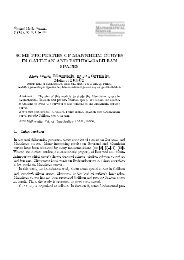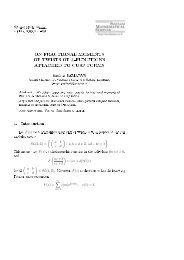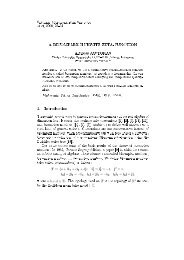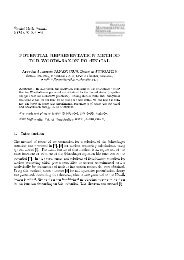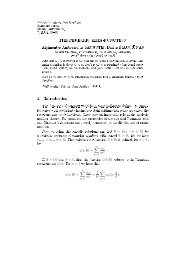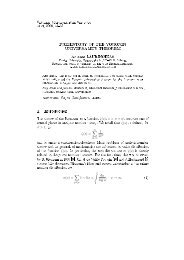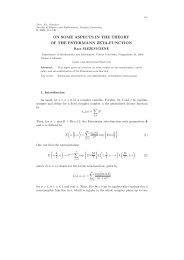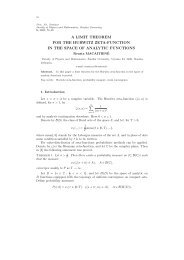savastru-varbanets-0..
savastru-varbanets-0..
savastru-varbanets-0..
Create successful ePaper yourself
Turn your PDF publications into a flip-book with our unique Google optimized e-Paper software.
’iauliai Math. Semin.,<br />
3 (11), 2008, 207219<br />
ON THE REPRESENTATION OF INTEGERS<br />
AS THE SUM OF kTH POWERS<br />
IN ARITHMETIC PROGRESSIONS<br />
Olga SAVASTRU, Pavel VARBANETS<br />
Odessa National University, Dvoryanskaya st.2, Odessa, 65026, Ukraine,<br />
e-mail: sav olga@bk.ru, varb@sana.od.ua<br />
Abstract. We investigate the behaviour of integers represented as the<br />
sum of k-th powers in arithmetic progressions. Using the Waring zeta-function<br />
introduced by A. Vinogradov, we prove the asymptotic formula for the<br />
summatory function of the number of representations of m as the sum of<br />
k-th powers in arithmetic progressions.<br />
Key words and phrases: asymptotic estimate, meromorphic continuation,<br />
Waring zeta-function.<br />
2000 Mathematics Subject Classication: 11N37.<br />
1. Introduction<br />
Dedicated to the 60th birthday<br />
of Professor Antanas Laurin£ikas<br />
Let α 0 , δ 0 ∈ (0, 1], α, δ ∈ (0, 1] n , and let n, k 2 be integers, k n<br />
We denote<br />
< n k.<br />
Θ k (x; α 0 , δ 0 ) =<br />
∞∑<br />
e −πx(m+δ 0) k e 2πimα 0<br />
.<br />
m=0<br />
For Re s > 1, consider the absolutely convergent series<br />
ζ n,k (s; α, δ) =<br />
∞∑<br />
( n∑ ) −s<br />
e 2πim α j +δ j )<br />
j=1(m k , m α = m 1 α 1 +. . .+m n α n ,<br />
m j =0<br />
1jn
208 O. Savastru, P. Varbanets<br />
which, for k = 2, n 2, coincides with the classical Epstein zeta-function,<br />
and, for k = n 3, α = δ = (0, . . . , 0), becomes the Waring zeta-function<br />
introduced for the rst time by A. Vinogradov [7]. Denote<br />
Then we obtain<br />
V n,k (λ; α, δ) =<br />
ζ n,k (s; α, δ) = ∑ λ>0<br />
∞∑<br />
m j =0<br />
n∑<br />
(m j +δ j ) k =λ<br />
j=1<br />
e 2πi(m 1α 1 +...+m nα n) .<br />
V n,k (λ; α, δ)<br />
λ s , Re s > 1.<br />
This function also will be called the Waring zeta-function.<br />
For α = δ = (0, . . . , 0), the function V n,k (λ; α, δ) denes the number of<br />
the representations of λ, λ ∈ N, as a sum of n kth powers of non-negative<br />
integers. A. Vinogradov obtained [7] the asymptotic formula<br />
∑<br />
mN<br />
V n,n (m; 0, 0) = P n<br />
(N 1 n<br />
)<br />
+ O<br />
(<br />
N 3 4 log 2 N<br />
where P n (u) is a polynomial of degree n with coecients depending on u.<br />
C. Hooley (see, [2][4]) considered the problem on the representation of<br />
positive integers as the sums of two or four h-powers. The Hooley method<br />
is very specic, and it is dicult to apply it in general case. Using a result<br />
of I. Vinogradov [8] on the famous Waring problem, S. Salerno studied [6]<br />
∑<br />
the distribution of square-free numbers n represented as r x k i in arithmetic<br />
i=1<br />
progression n ≡ 0( mod q) under condition r > (4+ε)k 2 log k, k > k 0 is large<br />
enough.<br />
In this paper, we study the function ζ n (s; α, δ), in particular, its behaviour<br />
in the region 1 2 Re s 1, and applying the Waring zeta-function, we<br />
construct the asymptotic formula for the summatory function of the number<br />
of representations of natural numbers as a sum of n summands of kth powers<br />
of non-negative integers.<br />
In the proof of the main theorem, we shall use the following statement.<br />
Let<br />
ζ(s; 0, δ) =<br />
∞∑<br />
(n + δ) −s , Re s > 1,<br />
n=0<br />
denote the Hurwitz zeta-function.<br />
)<br />
,
On the representation of integers... 209<br />
Lemma 1. Let s = σ + it, −2 σ 2, and let τ be a complex number with<br />
arg τ = ( π<br />
2 − |t|−1) sgn (Im s). Then there exists a constant t 0 > 1 such that<br />
the following approximate equation<br />
ζ(s; 0, δ) = 1 2<br />
where<br />
∑<br />
n∈Z<br />
|n+α|x log x<br />
+π − 1−2s<br />
2<br />
+π − 1−2s<br />
2<br />
F (s; |n + δ|τ 1 2<br />
√ π) + an F (1 − s; |n + δ|τ 1 2<br />
√ π)<br />
|n + δ| s<br />
Γ ( 1<br />
2<br />
(1 − s)) ∑<br />
2Γ( 1 2 s)<br />
n∈Z<br />
|n|y log y<br />
Γ ( 1<br />
2 (1 − s) + 1 ∑<br />
2<br />
2Γ( 1 2 s + 1 2 )<br />
+O ( x −M) + O ( y −M) ,<br />
a n =<br />
)<br />
n∈Z<br />
|n|y log y<br />
{<br />
sgn(n) if n ≠ 0,<br />
1 if n = 0,<br />
F (1 − s; |n|τ − 1 2<br />
√ π)e<br />
2πinδ<br />
|n| 1−s<br />
b n F (−s; |n|τ − 1 2<br />
√ π)<br />
|n| 1−s<br />
b n = −isgn(n)e 2πinδ ,<br />
√<br />
x = |t| 1 2 ( 2|τ|) −1 ,<br />
√<br />
y = |t| 1 2 |τ|( 2) −1 ,<br />
and M > 0 is an arbitrary constant, holds. Moreover, uniformly in all parameters<br />
t, τ, x, y, we have<br />
(<br />
F (ω, z) = l + O exp<br />
(<br />
− |z|2<br />
|t|<br />
)( ) |z| Re ω (<br />
1 +<br />
1<br />
|t| 1 ∣<br />
2<br />
2 |t| 1 |z| 2<br />
) −1 )<br />
2 − |t| 1 ∣ ,<br />
2<br />
where l = 1 if |n + δ| x and |n| y, and l = 0 otherwise; for the integral<br />
representation of F (ω, z), see [5].<br />
The lemma follows easily from the Lavrik work [5].<br />
Lemma 2. Let p be prime, n, k ∈ N, (p, k) = 1. Then the following estimates<br />
hold.<br />
∣<br />
p−1<br />
∑<br />
e 2πi m 1 x 1 +...+mnxn<br />
p<br />
x 1 ,...,x n =0<br />
n∑<br />
x k i ≡a( mod p) i=1<br />
<br />
∣<br />
{(k − 1) n p n−1<br />
2 if n = 3, 4,<br />
(k − 1) n p n 2 if n > 4,
210 O. Savastru, P. Varbanets<br />
Proof. The case n = 3 was considered by Hooley [3]. The case n = 4<br />
can be investigated similarly, and the general case follows from the Deligne<br />
work [1].<br />
Corollary. Let (k, q) = 1. Then, for (m 1 , . . . , m n , q) = 1, we have<br />
∑<br />
e 2πi m 1 x 1 +...+mnxn<br />
q<br />
x 1 ,...,x n ( mod q)<br />
n∑<br />
x k i ≡a( mod q) i=1<br />
≪ q κ τ(q),<br />
where κ = n−1<br />
2<br />
if n = 3, 4, κ = n 2<br />
if n 5, and the implied constant depends<br />
only on k and n.<br />
2. Analytic continuation of ζ n,k (s; α, δ)<br />
For λ > 0, the following equality<br />
λ −s =<br />
πs<br />
Γ(s)<br />
∫ ∞<br />
is true. Thus, we obtain that, for Re s > 1,<br />
ζ n,k (s; α, δ) =<br />
πs<br />
Γ(s)<br />
0<br />
∫ ∞<br />
0<br />
x s−1 e −πxλ dx, Re s > 0,<br />
x s−1 ( ∑<br />
λ>0<br />
V n,k (λ; α, δ)e −πxλ )<br />
dx. (1)<br />
Let σ l (α) denote an arbitrary collection of l elements of the set {α 1 , . . . ,<br />
α n } (the elements α i dier not by values but by indices). Let ∑ (α) be the<br />
l<br />
set of all collections of σ l (α). It is clear that ∑ (α) contains ( n<br />
) l<br />
elements.<br />
l<br />
So, from the denitions of V n,k (λ; α, δ) and Θ k (x; α 0 , δ 0 ) we obtain that<br />
∑<br />
V n,k (λ; α, δ)e −πxλ =<br />
λ>0<br />
=<br />
n∑ ∑<br />
∏<br />
l=1 σ l (α) α i ∈σ l (α)<br />
n∏<br />
j=1<br />
Θ k (x; α i , δ i )<br />
(Θ k (x; α j , δ j ) + 1) − 1, (2)<br />
where ∑ means that the sum runs over all m of the form m = (m 1 +<br />
m>0<br />
δ 1 ) k + . . . + (m n + δ n ) k , and ∑<br />
∑<br />
denotes . Here we take into<br />
σ l (α)<br />
σ l (α)∈ ∑ (α)<br />
l
On the representation of integers... 211<br />
account that the collections (α i1 , . . . , α il ) and (δ i1 , . . . , δ il ) are found in the<br />
one-to-one correspondence.<br />
Since the terms of the series for the Θ k decrease exponentially, we have<br />
that the behaviour of the integrand in (1) on [1, ∞) guarantee an analytic<br />
continuation of this part of integral to the whole complex plane. Therefore,<br />
it remains to consider the integral<br />
where<br />
F (s) =<br />
=<br />
=<br />
∫ 1<br />
0<br />
I(σ l (α)) =<br />
x s−1 ( ∑<br />
λ>0<br />
n∑ ∑<br />
∫ 1<br />
l=1 σ l (α) 0<br />
V n,k (λ; α, δ)e −πxλ )<br />
dx<br />
x s−1<br />
∏<br />
α i ∈σ l (α)<br />
Θ k (x; α i , δ i )dx<br />
n∑ ∑<br />
I(σ l (α)), (3)<br />
l=1 σ l (α)<br />
∫ 1<br />
0<br />
x s−1<br />
∏<br />
α i ∈σ l (α)<br />
Θ k (x; α i , δ i )dx. (4)<br />
In order to investigate the behaviour of the function Θ n,k (x; α i , δ i ) on the<br />
right of the point x = 0, we use the integral representation for this function.<br />
Consider the Mellin pair<br />
Γ(z) =<br />
∫ ∞<br />
0<br />
e −y y z−1 dy, e −y = 1<br />
2πi<br />
∫<br />
u+i∞<br />
u−i∞<br />
y −z Γ(z)dz, Re z = u > <strong>0.</strong><br />
Taking y = πx(m + δ i ) k , u = 1 n<br />
+ ε, ε > 0, we arrive at the relation<br />
ε+ 1 n +i∞ ∫<br />
Θ k (x; α 0 , δ 0 ) = 1 (πx) −z Γ(z)ζ(kz; α 0 , δ 0 )dz, (5)<br />
2πi<br />
ε+ 1 n −i∞<br />
where ζ(w; α 0 , δ 0 ), 0 < δ 1, is the Lerch zeta-function dened, for Re w > 1,<br />
by the Dirichlet series<br />
ζ(w; α 0 , δ 0 ) =<br />
∞∑<br />
m=0<br />
e 2πiα 0m<br />
(m + δ 0 ) w .
212 O. Savastru, P. Varbanets<br />
The function ζ(w; α 0 , δ 0 ) is entire, except for a simple pole at w = 1 with<br />
residue 1 if α 0 ∈ Z.<br />
In equality (5), move the contour of integration to the line Re z = −1+<br />
2k.<br />
1<br />
The integrand has a simple pole at z = 1 k<br />
(if α 0 ∈ Z), and a simple pole at<br />
z = <strong>0.</strong> Thus, we obtain that<br />
Θ k (x; α 0 , δ 0 ) = ε(α 0 ) Γ( 1 k )<br />
(<br />
+ ζ(0; α<br />
(πx) 1 0 , δ 0 ) + I − 1 + 1 )<br />
k<br />
2k ; x, α 0, δ 0 , (6)<br />
where<br />
I(b; x, α 0 , δ 0 ) = 1<br />
2πi<br />
∫<br />
b+i∞<br />
b−i∞<br />
{ 0 if α<br />
ε(α 0 ) =<br />
0 ∉ Z,<br />
1 if α 0 ∈ Z.<br />
Since, for x → +0, ∫∞<br />
I(b; x, α 0 , δ 0 ) ≪ x −b<br />
≪<br />
1<br />
∫∞<br />
x −b<br />
≪ x −b ,<br />
we obtain from (6)(7) that<br />
Θ k (x; α 0 , δ 0 ) = ε(α 0 ) Γ( 1 k )<br />
1<br />
(πx) −z Γ(z)ζ(kz; α 0 , δ 0 )dz, (7)<br />
|Γ(b + iv)||ζ(kb + ikv; α 0 , δ 0 )|dv<br />
|Γ(b + iv)|v 1 2 −b |ζ(1 − kb − ikv; −δ 0 , α 0 )|dv<br />
(πx) 1 k<br />
Now from (3), (4) and (8) we have that<br />
where<br />
F (s) =<br />
=<br />
n∑ ∑<br />
∫ 1<br />
l=1 σ l (α) 0<br />
× ∏<br />
α i ∈σ l (α)<br />
n∑<br />
l=0<br />
b k (l)<br />
s − l k<br />
b k (0) =<br />
x s−1<br />
(<br />
ε(α i ) Γ( 1 k )<br />
(πx) 1 k<br />
(∣ ∣∣∣<br />
+ O Re s + 1<br />
2k ∣<br />
n∑ ∑<br />
l=1 σ l (α) α i ∈σ l (α)<br />
+ ζ(0; α 0 , δ 0 ) + O(x 1− 1<br />
2k ). (8)<br />
+ ζ(0; α i , δ i ) + O ( x 1− 1<br />
2k<br />
) ) dx<br />
∏<br />
−1)<br />
, (9)<br />
ζ(0; α i , δ i ),
On the representation of integers... 213<br />
b k (n) =<br />
r =<br />
( ( ) ) 1 r<br />
Γ (π) − 1 k ,<br />
k<br />
n∑<br />
i=1<br />
α i =1<br />
1, (10)<br />
and b k (l), 0 < l < n, are polynomials in Γ( 1 k<br />
) with coecients which depend<br />
on α 1 , . . . , α n and δ 1 , . . . , δ n .<br />
Equality (9) gives meromorphic continuation of the Waring zeta-function<br />
to the half-plane Re s −1 +<br />
2k. 1 In view of (9), we see that ζ n,k (s; α, δ) has<br />
poles at the points s = k, l l = 0, 1, . . . , n.<br />
Now we will estimate the function ζ n,k (s; 0, δ) for 1 2<br />
< Re s 1 + ε. In<br />
(1), the integrand is holomorphic for Re s > <strong>0.</strong> Therefore, if |t| 1, we can<br />
turn by the angle ϕ = ( π<br />
2 − |t|−1) sgn(t) the ray of integration x ∈ [0, +∞).<br />
Hence, we have<br />
πs<br />
ζ n,k (s; α, δ) =<br />
Γ(s)<br />
∫ ∞<br />
x=0<br />
z s−1 ( ∑<br />
λ>0<br />
V n,k (λ; α, δ)e −πzλ )<br />
dz, (11)<br />
z = xe iϕ . This choice of the ray of integration shows that the Waring zetafunction<br />
has the power growth for |t| → ∞. We put<br />
ζ n,k (s; α, δ) =<br />
def<br />
π s<br />
Γ(s)<br />
= ζ (1)<br />
n,k<br />
⎛<br />
⎝<br />
∫ 1<br />
Now, using the well-known estimate<br />
we nd that<br />
ζ (2)<br />
n,k (s; α, δ) = ∑ λ>0<br />
0<br />
I λ (s) = 1<br />
Γ(s)<br />
By a trivial estimate ∑<br />
deduce from (14) that<br />
+<br />
∫ ∞<br />
1<br />
⎞ (<br />
⎠<br />
z s−1 ∑ λ>0<br />
V n,k (λ; α, δ)e −πzλ )<br />
dz<br />
(s; α, δ) + ζ(2)<br />
n,k<br />
(s; α, δ). (12)<br />
∫ ∞<br />
x=λ<br />
z=xe iϕ<br />
V n,k (λ; α, δ)<br />
m s I m (s) ≪ ∑ λ>0<br />
λx<br />
∫∞<br />
ζ (2)<br />
n,k (s; α, δ) ≪ ∑<br />
V n,k (λ; α, δ) ≪ x n k<br />
λ 0<br />
λx<br />
z s−1 e −z dz ≪ e − λ<br />
|t|<br />
, (13)<br />
V n,k (λ; α, δ)<br />
λ σ e − λ<br />
|t|<br />
. (14)<br />
and partial summation, we<br />
(<br />
V n,k (λ; α, δ)<br />
λ σ e − x<br />
|t|<br />
1 + x ) dx<br />
|t| x σ+1
214 O. Savastru, P. Varbanets<br />
≪<br />
min<br />
(<br />
λ n k −σ<br />
)<br />
0<br />
n<br />
k − σ , |t| n k −σ log |t| + |t| n k −σ , (15)<br />
λ 0<br />
λ 0 = δ k 1 + . . . + δk n. Hence, in view of (3)(5), we obtain that, for Re s > 1 2,<br />
where<br />
n∑<br />
ζ (1)<br />
n,k<br />
(s; α, δ) =<br />
∑<br />
l=1 σ l (α)<br />
π s<br />
Γ(s)<br />
∫ 1<br />
x=0<br />
x s−1 e iϕs G(x, σ l (α))dz,<br />
and<br />
G(x, σ l (α)) =<br />
∏<br />
α j ∈σ l (α) 1<br />
1<br />
2k +i∞ ∫<br />
ζ (1)<br />
n,k (s; α, δ) = πs e iϕs<br />
Γ(s)<br />
2k −i∞ e iw j<br />
(πx) −w j<br />
Γ(w j )ζ(kw j ; α j , δ j )dw j ,<br />
×<br />
l∏<br />
j=1<br />
n∑ ∑<br />
∫<br />
∫<br />
· · ·<br />
l=1 σ l (α)<br />
Re w j = 1<br />
2k<br />
1jl<br />
e iϕw j<br />
Γ(w j )<br />
ζ(kw j ; α j , δ j ) dw 1 . . . dw l<br />
s − w 1 − w l<br />
. (16)<br />
The integrals on w j , j = 1, . . . , l, can be calculated by the method of stationary<br />
phase using the Stirling formula for Γ(w) and the approximate functional<br />
equation for ζ(s; α, δ), see Lemma 1. We have<br />
n∑<br />
ζ (1)<br />
n,k<br />
(s; α, δ) ≪<br />
∑<br />
∑<br />
l=1 σ l (α) α∈σ l (α)<br />
∑<br />
V l,k (λ; α, δ)<br />
(17)<br />
(σ − 1 λλ 0<br />
2 ) + ||t| − λ|.<br />
The main contribution in (16) is given by the summand with l = n , and<br />
then σ l (α) = (α 1 , . . . , α l ), λ 0 = δ k 1 + . . . + δk n. Hence, and from (12), (15)<br />
and (17) we obtain that, for Re s > 1 2,<br />
( )<br />
ζ n,k (s; α, δ) ≪ |t| n 1<br />
k −σ min<br />
n<br />
k − σ , log(|t| + 3)<br />
+ ∑ V n,k (m; α, δ) λ<br />
(σ − 1 m 2<br />
) + ||t| − m|e−<br />
|t|<br />
. (18)
On the representation of integers... 215<br />
3. Sum of n kth powers in arithmetic progression<br />
Recall that V n,k (m) denotes the number of representations of a natural<br />
m as a sum of n kth powers of non-negative integers, i.e.,<br />
∑<br />
V n,k (m) =<br />
1. (1)<br />
x 1 ,...,x n0<br />
x k 1 +...+xk n=m<br />
Since we have not an acceptable estimate for V n,k (m), we cannot use the<br />
lemma on partial sums of Dirichlet series. Therefore, we apply the Perron<br />
formula for calculation of the weighted mean for V n,k (m). We have that<br />
∑<br />
m≡a( mod q)<br />
mN<br />
V n,k (m)(1 − m N ) = 1<br />
2πi<br />
where δ = ( l 1<br />
q<br />
, . . . , ln q ), ∑<br />
n∑<br />
li k<br />
i=1<br />
≡ a( mod q).<br />
(a,q)<br />
c+i∞ ∫<br />
c−i∞<br />
1 ∑<br />
q ks<br />
(a,q)<br />
N s<br />
ζ n,k (s; 0, δ) ds, (2)<br />
s(s + 1)<br />
denotes a summing over l 1 , . . . , l n ( mod q), and<br />
We consider only the case k 2 < n k because for n k 2<br />
we cannot dene<br />
the main term in the asymptotic formula.<br />
By (14) and (16) it is clear that we can move the contour of integration<br />
in (2) to the line Re s = σ 0 > 2. 1 This gives<br />
∑<br />
m≡a( mod q)<br />
mN<br />
V n,k (m)<br />
= N n,k (a, q) ∑<br />
+ 1<br />
2πi<br />
∫<br />
σ 0 +i∞<br />
(<br />
1 − m N<br />
)<br />
( ) l<br />
N k<br />
a n,k (l)<br />
q k k<br />
2
216 O. Savastru, P. Varbanets<br />
Let, for Re s > 1,<br />
Obviously,<br />
Z n,k (s; a, q) =<br />
∞∑<br />
m=1<br />
m≡a( mod q)<br />
Z n,k (s; a, q) = 1<br />
q ks ∑<br />
(a,q)<br />
V n,k (m)<br />
m s .<br />
ζ n,k (s; 0, δ).<br />
Then, similarly to the proof of relation (12), we can obtain that, for Re s 1 2,<br />
|Im s| > 1,<br />
where<br />
and<br />
Z n,k (s; a, q) = Z (1)<br />
n,k<br />
(s; a, q) + Z(2)<br />
n,k<br />
(s; a, q), (4)<br />
∫ 1<br />
Z (1)<br />
πs ∑<br />
n,k<br />
(s; a, q) = x s−1 e iϕs q −ks<br />
Γ(s)<br />
(a,q) 0<br />
n∑ ( n<br />
) ( ( ) 1<br />
× Γ (πxe iϕ ) − 1 k<br />
l k<br />
l=1<br />
( )) 1<br />
l<br />
+I<br />
2k ; x, 0, δ i dx, (5)<br />
Z (2)<br />
∞ n,k<br />
(s; a, q) =<br />
∑<br />
m=1<br />
m≡a( mod q)<br />
V n,k (m)<br />
m s I m (s). (6)<br />
The denitions of I(b; x, α 0 , δ 0 ) and I m (s) are given in (7) and (13), respectively.<br />
After some simple transformations of the integrand in (5), we obtain that<br />
Z (1)<br />
πs<br />
n,k<br />
(s; a, q) =<br />
Γ(s) eiϕs q −ks<br />
( π<br />
s<br />
+O<br />
Γ(s)<br />
( ∑<br />
×<br />
(a,q)<br />
n∑ a n,k (l)<br />
s − l N n,k (a, q)<br />
l=1 k<br />
n∑<br />
∫ 1<br />
∣ x s−1 e iϕs q −ks<br />
l=1<br />
0<br />
l∏<br />
( 1<br />
I<br />
2k ; x, 0, l ))<br />
)<br />
i<br />
dx<br />
q ∣<br />
i=1<br />
. (7)
On the representation of integers... 217<br />
The main contribution in the error term in (7) is given by the summand with<br />
l = n. In order to estimate the integral<br />
Φ(s) =<br />
∫ 1<br />
0<br />
π s e iϕs<br />
Γ(s) xs−1 q −ks ⎛<br />
we use (7). This leads to the estimate<br />
where<br />
∫<br />
Φ(s) ≪<br />
∣<br />
∫<br />
· · ·<br />
Re w j = 1<br />
2k<br />
1jn<br />
q −ks πs e iϕs<br />
Γ(s)<br />
∑ ∑<br />
(ζ) = ζ<br />
(a,q)<br />
⎝ ∑ (a,q)<br />
n∏<br />
i=1<br />
Γ(w 1 ) . . . Γ(w n )<br />
π (w 1+...+w n )<br />
( 1<br />
I<br />
2k ; x, 0, l ) ⎞<br />
i<br />
⎠ dx<br />
q<br />
(<br />
kw 1 ; 0, l ) (<br />
1<br />
. . . ζ kw n ; 0, l )<br />
n<br />
.<br />
q<br />
q<br />
∑<br />
(ζ)<br />
dw 1 . . . dw n<br />
s − w 1 − w n<br />
∣ ∣∣∣∣∣∣∣∣∣<br />
, (8)<br />
Applying the approximate functional equation for the Hurwitz zeta-function<br />
ζ(kw; 0, δ) with |τ| = |t| − 1 2 log −1 (|t| + 3), see Lemma 1, we easily nd that<br />
Φ(s)<br />
≪<br />
∞∑<br />
m j =1<br />
1jn<br />
∫<br />
× ∣<br />
∣ eiϕs<br />
∣∣ ∑ Γ(s)<br />
(a,q)<br />
∫<br />
· · ·<br />
Re w j = 1<br />
2k<br />
1jn<br />
n∏<br />
j=1<br />
e 2πi m 1 l 1 +...+mnln<br />
q<br />
Γ(w j )<br />
π w jm w jk<br />
j<br />
∣<br />
dw 1 . . . dw n<br />
s − w 1 − w n<br />
∣ ∣∣.<br />
Computing the integrals by the method of stationary phase, we obtain<br />
Hence,<br />
Φ(s)<br />
≪<br />
≪<br />
∞∑<br />
m j =1<br />
1jn<br />
∣ ∑ (a,q)<br />
e 2πi m 1 l 1 +...+mnln<br />
q<br />
e − (mk 1 +...+mk n )<br />
|t|<br />
×<br />
(σ − 1 2 ) + ||s| − mk 1 − . . . − mk n| q−kσ<br />
∞∑<br />
m=1<br />
∣<br />
V n,k (m)e − m |t|<br />
(σ − 1 2 ) + ||t| − m| qκ−kσ . (9)<br />
Z (1)<br />
n,k (s; a, q) = N n,k(a, q) πs<br />
Γ(s) eiϕs q −ks<br />
n∑ a n,k (l)<br />
l=1<br />
s − l k<br />
N l q
218 O. Savastru, P. Varbanets<br />
+<br />
Moreover, using the estimates<br />
and<br />
∑<br />
m≡a( mod q)<br />
mX<br />
V n,k (m) = ∑ (a,q)<br />
∑<br />
m≡a( mod q)<br />
mX<br />
∞∑<br />
m=1<br />
V n,k (m)e − m |t|<br />
(σ − 1 2 ) + ||t| − m| qκ−kσ . (10)<br />
∑<br />
m i<br />
∑ (mi +δ i ) k <br />
V n,k (m) e− m |t|<br />
we obtain by partial summation that<br />
Z (2)<br />
n,k<br />
(<br />
) 1<br />
k<br />
X<br />
q k<br />
(<br />
n<br />
X<br />
)<br />
k<br />
1 ≪ N n,k (a, q)<br />
q n + 1<br />
m σ ≪ q n k −σ if |t| q, (11)<br />
(s; a, q)<br />
⎧<br />
⎨q n k −σ if |t| q,<br />
≪ ( n<br />
⎩ |t|<br />
−σ<br />
)<br />
k<br />
q<br />
+ |t| −σ min ( 1<br />
n n<br />
k −σ , log(|t| + 3)N n,k(a, q) ) if |t| < q.<br />
Thus, taking σ = 1 2 + 1<br />
log N<br />
, we obtain by (4), (10) and (12) that<br />
∑<br />
m≡a( mod q)<br />
mN<br />
(<br />
V n,k (m) 1 − m )<br />
N<br />
= N n,k (a, q)<br />
(<br />
+O<br />
n∑<br />
l=1<br />
a n,k (l)<br />
)<br />
q l N l q + O<br />
(N 1 n<br />
2 q k − 1 2 log 2 N<br />
)<br />
N n,k (a, q)N 1 2 q<br />
− 3 2 log 2 N<br />
)<br />
+O<br />
(N 1 2 q<br />
κ− k 2 τ(q) log N<br />
(12)<br />
, (13)<br />
where a n,k (n) =<br />
(<br />
1<br />
π Γ( 1 k ) ) n<br />
, the constants a n,k (l), 1 l n, are computable,<br />
and the O-constants do not depend on N and q. From this, by standard way,<br />
we obtain the following statement.<br />
Theorem. Let V n,k (m) denote the number of the representations of m as the<br />
sum of n kth powers, and let a, q, N be natural numbers. Then the following<br />
asymptotic formula
On the representation of integers... 219<br />
∑<br />
m≡a( mod q)<br />
mN<br />
V n,k (m)<br />
= N n,k (a, q)<br />
+O<br />
n∑ a n,k (l)<br />
N l q + O<br />
(N 3 2n−k<br />
4 q 2k<br />
q l<br />
l=1 )<br />
(N 3 4 q<br />
κ− k 2 τ(q) log N<br />
)<br />
− 1<br />
2 log 2 N<br />
(<br />
)<br />
+ O N n,k (a, q)N 3 4 q<br />
− 3 2 log 2 N<br />
holds. Here N n,k (a, q) = #sol{x k 1 + . . . + xk n ≡ a( mod q), 0 x i q − 1},<br />
{ n−1<br />
κ = 2<br />
if n = 3, 4,<br />
n<br />
2<br />
if n 5,<br />
and τ(q) is the number of divisors of q.<br />
References<br />
[1] P. Deligne, La conjecture de Weil. I, II, IHES Publ. Math. 43 (1974), 273307,<br />
52 (1980), 137252.<br />
[2] C. Hooley, On the representation of a number as the sum of four cubes. I,<br />
Proc. London Math. Soc.(3) 36 (1978), 11714<strong>0.</strong><br />
[3] C. Hooley, On the numbers that are representable as the sum of two cubes. I,<br />
Reine Angew. Math. 314 (1980), 146173.<br />
[4] C. Hooley, On another sieve method and the numbers that are a sum of two<br />
hth powers, Proc. London Math. Soc. (3) 43 (1981), 73109.<br />
[5] A. Lavrik, Approximate functional equation for the Dirichlet L-functions, Tr.<br />
Mosk. Mat. O.-va 18 (1968), 91104 (in Russian).<br />
[6] S. Salerno, On the distribution of x k 1 + . . . + x k s in the arithmetic progression,<br />
Studio Scient. Math. Hung. 20 (1985), 357374.<br />
[7] A. I. Vinogradov, Waring zeta-function, in: Collection of Papers Dedicated<br />
to the 60th Birthday of Prof. V. Sprindzuk, 3340, 1997 (in Russian).<br />
[8] I. M. Vinogradov, The Method of Trigonometric Sums in the Theory of Numbers,<br />
Interscience, London, 1954.<br />
Received<br />
31 January 2008



